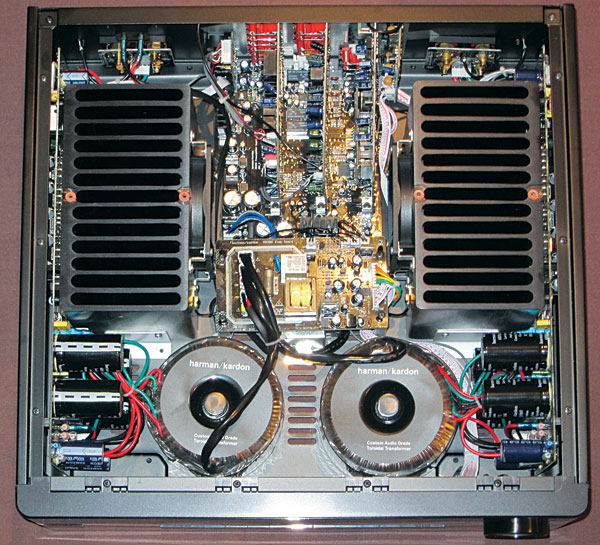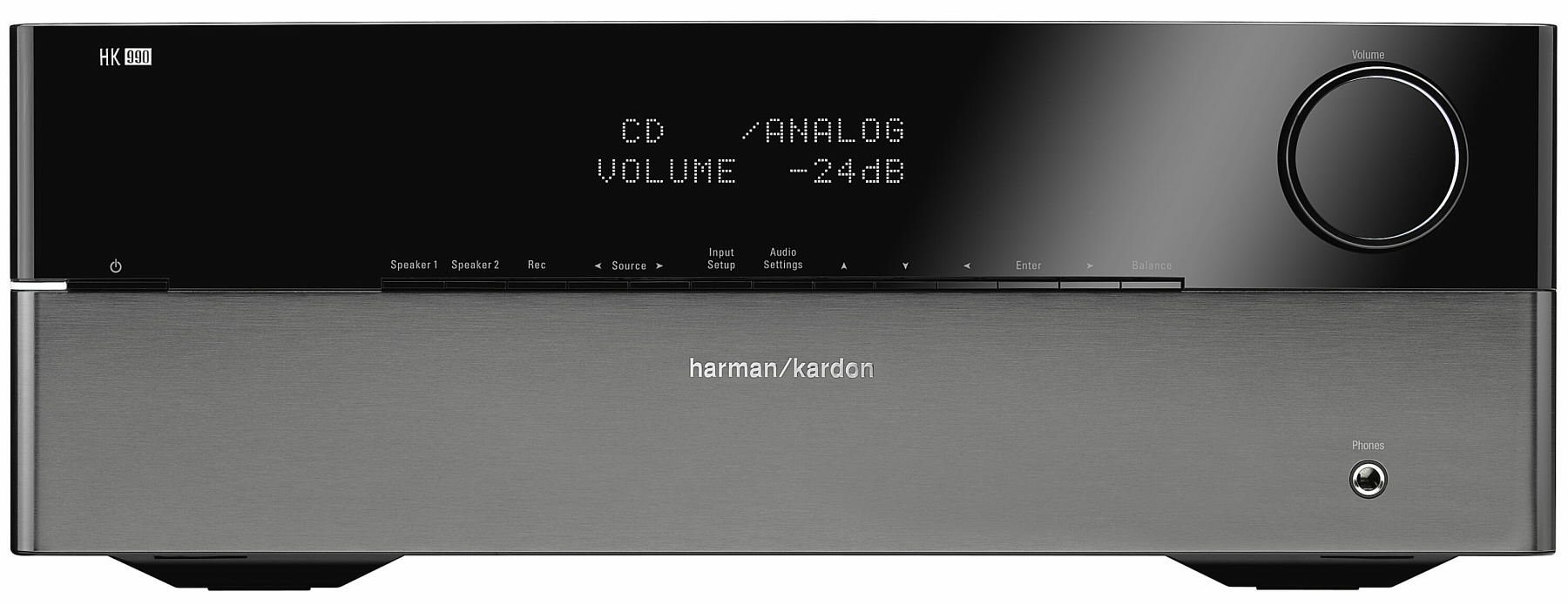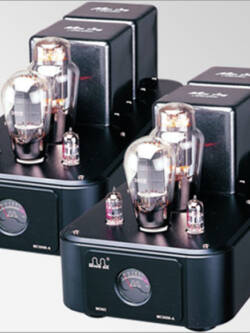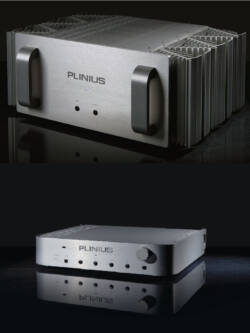Harman Kardon HK 990 Amplifier
Original price was: R48,000.00.R14,800.00Current price is: R14,800.00.
Specifications
- HK 990
- Design: Solid State Stereo Integrated Amplifier
- Power: 2 x 150 watts RMS into 8 ohms @ 20 Hz – 20 kHz, 2 x 300 Watts into 4 Ohms
- MFR: 10 Hz – 100 kHz
- THD: <0.07% at Full Output (8 Ohm Load)
- Analog Inputs: 7, Plus 1 Phono MC, 1 Phono MM, and 1 Balanced XLR
- Digital Inputs: 1 HRS-Link, 2 Optical Digital, 2 Coaxial Digital
- Analog Input Sensitivity/Impedance: 350mV/43k ohms for tuner/CD, 10mV/47k ohms for Phono-MM, 1mV/100k ohms for Phono-MC
- Digital Input Capability: All Standard Digital Formats
- Dimensions: 6.4″ H x 17.3″ W x 17.5″ D
- Weight: 43.2 Pounds
- MSRP: $2,599 USA
Description
Design
The HK 990 and HD 990 are certainly befitting products from a company with numerous design awards. The overall look of both components is clean and modern, with sharp lines contrasted by gently rounded corners. While some may find the front panel designs “minimalist,” I absolutely loved them and feel that the design theme will age extremely well. In a bit of a contrast to the current all-black (or all-silver) theme most companies have adopted, the units both sport a two-tone design of gloss black top halves with a dark pewter bottom half. While I typically prefer all black myself, I really liked having this bit of extra flash in my equipment rack. As a testament to the beautiful design, numerous houseguests commented that the HK 990/HD 990 looked very expensive. Also drawing numerous “oohs and aahs” were the white lighting on both components when powered up. The volume control knob on the HK 990 is particularly neat, with its white light illuminating the volume knob from within.

My only criticism of the design of both units’ centers is the front-panel buttons. Frankly, the labeling is impossible to see in the dark and since all of the buttons are the exact same size and shape, you can’t identify them by touch either. Being that most users will typically use the remote control, this is a minor issue, but one I feel I must mention. Speaking of the remotes, the unit included with the HK 990 is an interesting design. The remote is not the most comfortable to hold, but there are buttons for every function I ever needed, including a dedicated button for the “EQ Preset,” which I’ll cover later. The HK 990’s remote can also control the HD 990 and is missing only one button from the HD 990: “source.” It can be programmed to control numerous other components as well. The remote for the HD 990 is simpler, but is far more comfortable to hold. It includes everything one would expect from a CD player remote, including dedicated buttons to help you move through folders of MP3s. To be honest, I never even had to use the HD 990 remote as the HK 990’s was able to do everything required for both devices. My biggest complaint with both remotes is that they aren’t backlit, so they are very hard to use in the dark.
The back panel of the HK 990 is well equipped. There are 7 analog RCA inputs, plus 1 phono Moving Magnet (MM) and 1 phono Moving Coil (MC). There is also a single pair of balanced XLR connectors for use with the CD input only. This is a truly balanced, dual-differential design. The RCA input labeled “Processor” is basically a home theater bypass and passes the incoming signal directly to the HK 990s amplifier section at full strength. There are two subwoofer inputs that can be utilized with the home theater bypass functionality as well. On the digital side of things, there are 2 coaxial digital inputs and 2 optical digital inputs. There is also the proprietary HRS-Link connection, which looks just like a standard Ethernet port. There are RCA pre-outs for the left and right channels as well as two subwoofer channels, which is a very nice touch. The EZSet/EQ can calibrate the system for two subwoofers, which could be very useful for those of you running more than one sub. There is also a coaxial digital output as well as two other RCA record outputs. Rounding out the connections is an RS-232 control, IR in/out, and two 12v subwoofer triggers. The HK 990 can also be used to drive two pairs of speakers via the four sets of well-built binding posts. However, if you wish to run two pairs of speakers make sure that they are both 8 ohm or higher loads; otherwise you could damage the amplifier section. The only things missing are USB (asynchronous), RJ45, and iPod connectivity. I can definitely see some users wishing they could send their computer/network-based audio directly into the HK 990.
The HD 990’s back panel has a few more options than most CD players I’ve used. Besides analog RCA, HRS-Link, coaxial digital, and optical digital outputs there is also a fully balanced XLR output (with dual Diamond Class A output stages) which is rarely seen on a player in this price range. Of further interest are the coaxial digital and optical digital inputs. The HD 990 can take a digital feed from other source components with lesser quality DACs, convert them to analog using its own Analog Devices AD1955 DAC, and then pass them along to the HK 990 or other connected device.
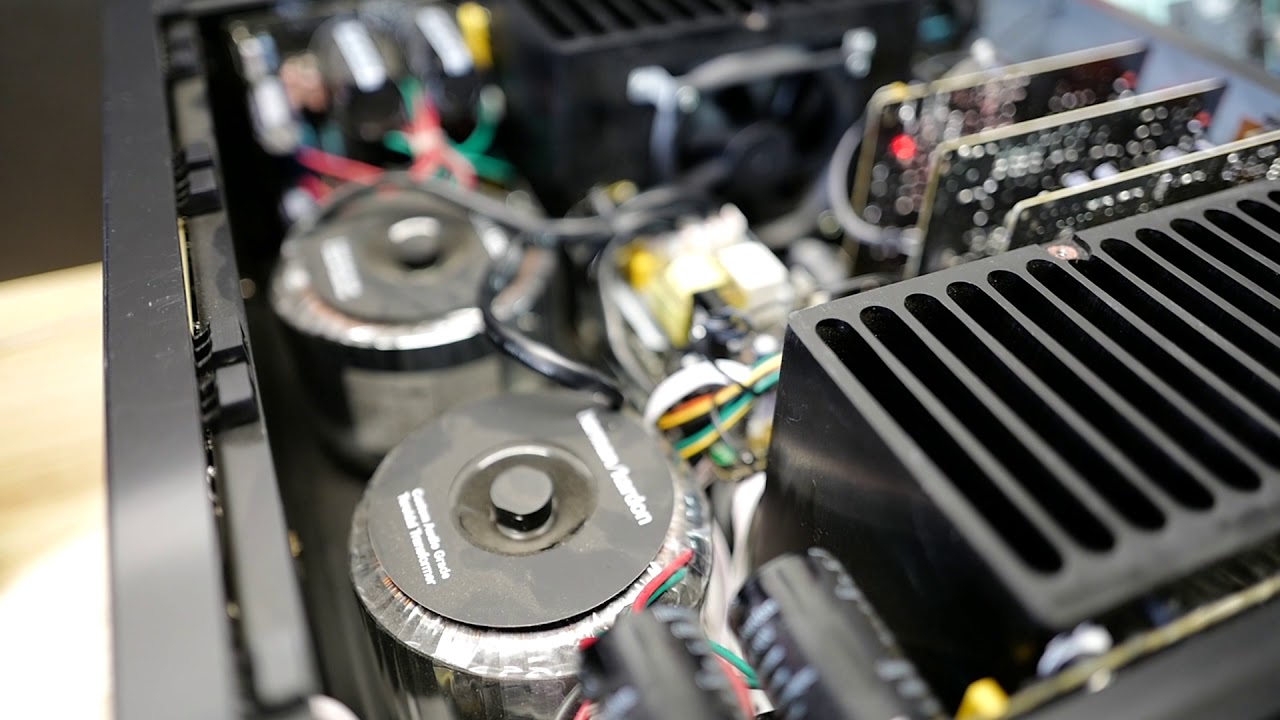
Build quality of both components is excellent. My first surprise of this review came when I went to retrieve the HK 990 from my front porch after it was delivered. I hadn’t checked all of the specs on the unit yet, so I was expecting a normal mass-market 25 pound 2-channel “receiver.” Well, the shipping weight on the HK 990 is closer to 50 pounds, so the laugh was on me. Wondering if they packed a bit of lead in with the amplifier, I tore the box open and checked things out. No lead could be found, but it was pretty obvious that Harman Kardon hadn’t taken any shortcuts with this thing. The HK 990 is beautifully constructed, with absolutely no flex to the chassis whatsoever. Fit and finish is excellent and in line with a product of this price. The center of the chassis contains two large heat sinks/air channels, which keep the amplifier cool.
After removing the top plate of the HK 990, I could see that the internal construction is up to snuff as well. The two toroidal transformers are massive (16,000µF of supply filtering per channel), and the circuit board layout is neat and clean. Component quality appeared to be first-rate as well. A lot of thought went into the internals of the HK 990 including dual-path technology for allowing pure analog and pure digital audio processing within the same chassis, dual differential input stages with their own high-voltage supply, a cascaded pre-driver stage to reduce high-frequency distortion, thermal tracking to bias the current of the output stage in real time, and a DC servo to ensure that the DC level of the amplifier output remains within a set limit. It has been a long time since I have seen this level of quality construction from a “mainstream” manufacturer.
The HD 990, while not having the mass of the HK 990, is also nicely built. The chassis is solid, and the CD drawer is quiet and smooth without displaying the “chintzy” feel that so many plastic drawer trays have today. My only quibble revolves around the HK 990’s volume control knob. While I loved the white backlighting, the plastic knob itself has a fair amount of play and wiggle to it that just doesn’t match up with the overall quality of the rest of the unit. I’d like to see something a bit sturdier in the future.
Setup
After appreciating the build quality and overall design of the HK 990 and HD 990, I have to admit that my expectations had been raised significantly and I could not wait to get both components set up and running. As this would be a strictly 2-channel review, I slid the HK 990/HD 990 into the rack in my den listening room and connected my Paradigm Reference Studio 20 V3 speakers mounted on Dynaudio Stand 4 speaker stands via Tributaries 12 gauge speaker cable. Source components were my faithful Yamaha DVC-750 5 –disc SACD/DVD-A/CD player and of course, the HD 990. I hooked the Yamaha up via analog RCA so that I could enjoy 2-channel SACD and DVD-Audio discs and connected the HD 990 via analog RCA, digital coaxial, and HRS-Link so that I could compare the differences between the three connection types. With all of the connections made, I went through the easy to use setup menu to associate the named inputs with their requisite analog or digital source. The front panel of the HK 990 shows all of this information clearly, so if you’ve been spoiled by the on-screen GUIs of recent home theater-geared equipment, don’t worry. I also appreciated the HK 990’s ability to set a level for each input. This allows you to adjust the “gain” for each source input to ensure that you get the same overall volume level when switching between sources. Every receiver/pre-amp/integrated should have this extremely useful feature.
With all of my sources configured, I moved on to the EZSet/EQ feature. Similar to other automated room EQ systems like Audyssey, the EZSet/EQ attempts to correct the sound at your listening position for any anomalies caused by your listening environment. After connecting the included microphone to the front panel jack, the process is simple. Press the “Speaker Setup” button on the front panel of the HK 990 or the remote and the calibration process beings with the choice of a manual or automated setup. Manual is good if you only want to set the crossover point for your subwoofers (if you have any). If you select the automated routine, tell the system if you have one or two (or zero in my case) subwoofers connected. If you do have a sub, you have the option of configuring a crossover point manually or letting EZSet/EQ decide for you. If you chose the manual option, you’d set the crossover point now. Choices range from 40Hz to 200Hz at 10Hz intervals. With the crossover set, the system asks you to place the included microphone at the listening position. Be sure to set it at ear-level for best results. After two frequency sweeps, you will be asked to place the mic two feet in front of the left speaker for additional measurements. You finish up by placing the mic two feet in front of the right speaker and letting the frequency sweeps run again. Don’t forget to hit the “enter” button on the remote to save the configuration once complete.
Once you’ve completed the EQ setup, you gain access to four sound modes for digital sources. The first is “DSP,” which runs the signal through the A/D converter, DSP chip, and D/A converter prior to volume adjustment. DSP mode allows access to the tone control circuitry if you wish to adjust bass or treble response. Next is “EQ1,” which only applies room equalization to the subwoofer (if connected) frequencies. Then there is “EQ2” where subwoofer and midrange frequencies up to 1kHz are corrected, leaving the treble response unaltered. Finally there is EQ3, which applies compensation over the entire frequency spectrum. You can also go back into the “input setup” menus to apply DSP to analog sources, which then allows you to adjust gain, bass, and treble or apply any of the three EQ settings.

In Use
HK 990 Integrated Amplifier
My first listening experience with the HK 990/HD 990 duo was a bit of a revelation for me. Typically, an old Denon 3802 A/V receiver powers the Paradigm Reference Studio 20s that sit in my den listening room. While I’ve heard enough high-quality gear to realize my Denon is by no means state-of-the-art, I was completely unprepared for how much better the HK 990 made things sound. I typically run through a set of demo tracks when I first fire up a component to get an overall feel for how a new piece of gear sounds and to get a “pre-break-in” benchmark. As soon as I started playing my first track my wife came downstairs, walked into the den and said, “Wow, it sounds so much clearer.” She stood and listened for about a minute, saw the evil glint in my eye and then asked, “What are these going to cost me?” She knows me far too well. What really shocked me was that I had just fired the HK 990 up, so there had been absolutely no warm up or break-in time yet. Things could only get better from here and I rubbed my little paws together with glee.
I used the HK 990/HD 990 for about four weeks (about 100 hours) of casual music listening before settling down for any critical sessions. To be honest, I did not notice any appreciable difference in sound quality versus the out-of-the-box state, so break-in is probably not necessary with the HK 990. I did feel that the amp needed about 15-20 minutes of playback before sounding its best though, so keep that in mind when you demo the product. I did my first listening session with my Yamaha changer as the source, so I could get a feel for the sound of just the HK 990. I kept all DSP/EQ modes off, keeping things in the most pure “Direct” mode. I started with my long-running favorite demo, Reference Recording’s “Symphonic Dances” by Rachmaninoff (RR-96CD). In a word, the sound was stunning.
The first thing I noticed was the absolute clarity of the signal. The noise floor was so much lower than I was used to. There was no hash or grain to the sound, which just made musical details stand from the background. This led to a vast improvement in apparent detail, without any extra brightness or glare. Even detail in the bass was improved, making things like tympani hits easier to distinguish from one another. Treble detail also improved remarkably, without any extra bite or brittleness to the sound. Mid-range tones were clear and beautiful. I also found that the soundstage width and depth had increased noticeably. Imaging was improved as well; it was now easier than ever to pick out where certain instruments were arranged in the mix. The most noticeable improvement had to be in the bass though. The HK 990 took firm control over the 7″ midrange/woofer in my Studio 20s, resulting in much tighter, punchier bass attack. Bass definition, pitch, and rhythm were also noticeably improved. Even more surprising to me was that it sounded like I was getting slightly deeper bass as well. Perhaps it was the increased power of the HK 990, but all of these attributes helped give the music a large increase in dynamic punch, which suited this type of large scale symphonic track very well.

Next I queued up “Mediterranean Nights” (Avalon B0001LJCZW) and put on track 13, “Hasta Pronto.” This track has a quick moving natural bass line that can get a bit muddy on a less revealing system. It was remarkably clear and easy to follow with HK 990 in my system and also seemed to reach a bit deeper as well. Besides the bass, the Spanish guitar sounded just right and the hand claps that run throughout the song were completely natural sounding. I also played track 9 from this disc, “Con Ternura,” as it is one of the most beautiful, yet haunting guitar melodies I’ve ever heard. The tone was perfect, with natural decay to the individual notes and a great sense of reverberation (probably studio enhanced just a bit) from the body of the guitar.
Vocals tracks shined just as much as instrumentals through the HK990. I put on the 2-channel SACD track from Diana Krall’s “Love Scenes”(Verve B0002DSUEI) and skipped right to track 11, “My Love Is.” While this disc sounds great on just about any system, I was particularly impressed with it through the HK 990. The natural bass intro was awesome, and Krall’s voice sounded even smoother and sultrier (is that even possible?). After listening to a few other tracks off the disc, I moved over to Melody Jardot’s “My One and Only Thrill” (Verve B002RD4UZ4). “Who Will Comfort Me” and “Your Heart Is As Black As Ice” both sounded wonderful, with Ms. Jardot’s beautiful tone ringing through clearly. This CD is not as slickly produced as the Diana Krall SACDs, but it still sounded great.
After playing some additional rock and electronic tracks, I realized that I had never heard my Paradigm speakers sound so good. Maybe it was just equipment synergy, but the HK 990 and Studio 20 V3s made for a marvelous pairing. The HK 990 made my Paradigm’s sound like a far better speaker, and they aren’t too shabby to begin with. Even so, I found myself wishing that I still had the excellent Dynaudio X16s (see my review here) around. The tonal qualities and increased resolution of the Dynaudios plus the beautiful tone, clarity, and punch of the HK 990 would most likely be a match made in heaven. Bottom-line, the HK 990 is certainly up to the task of driving any high quality “audiophile” speaker.
